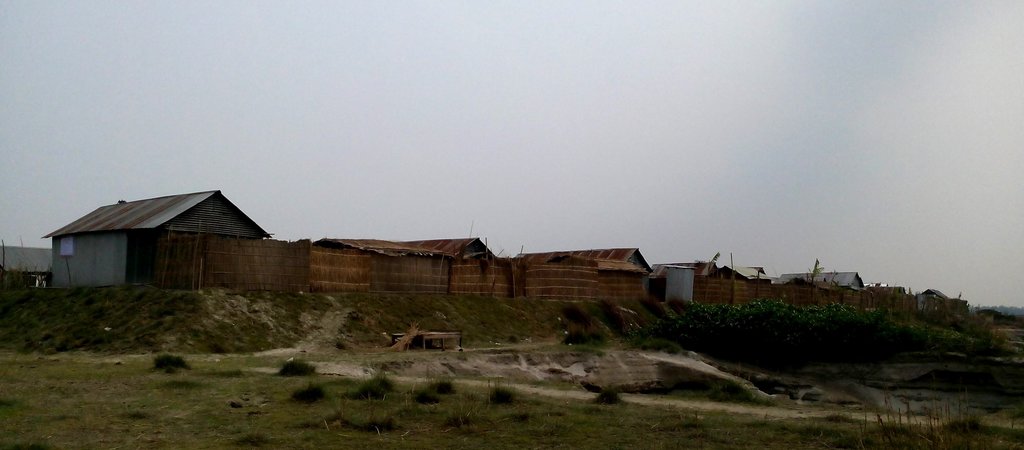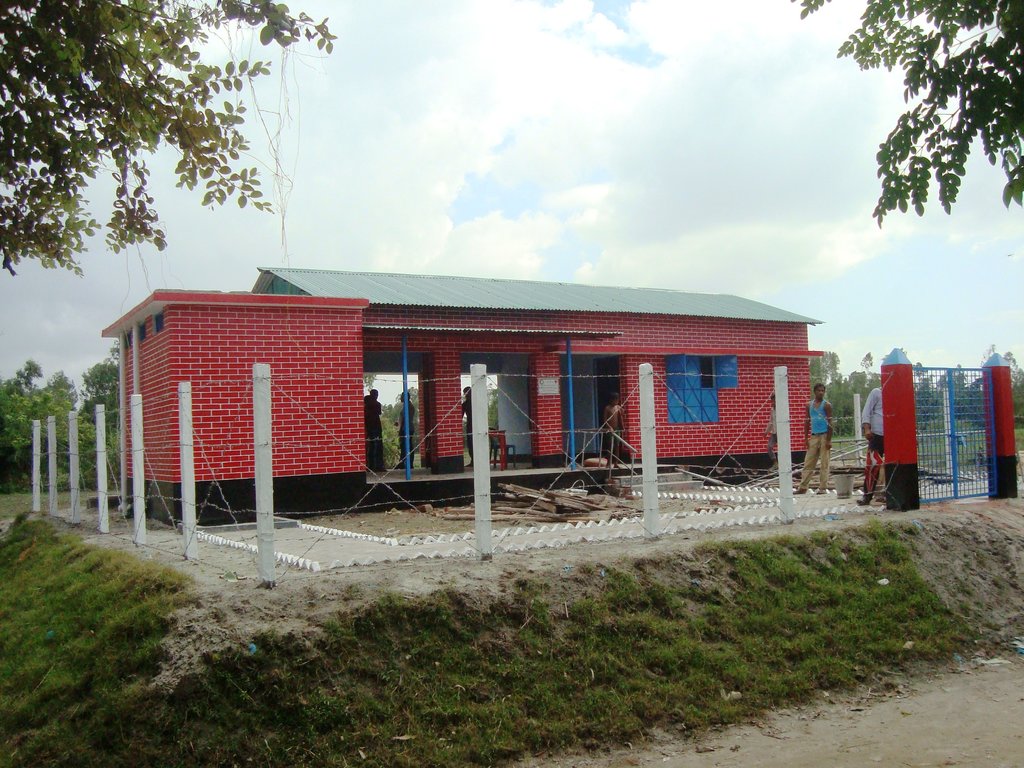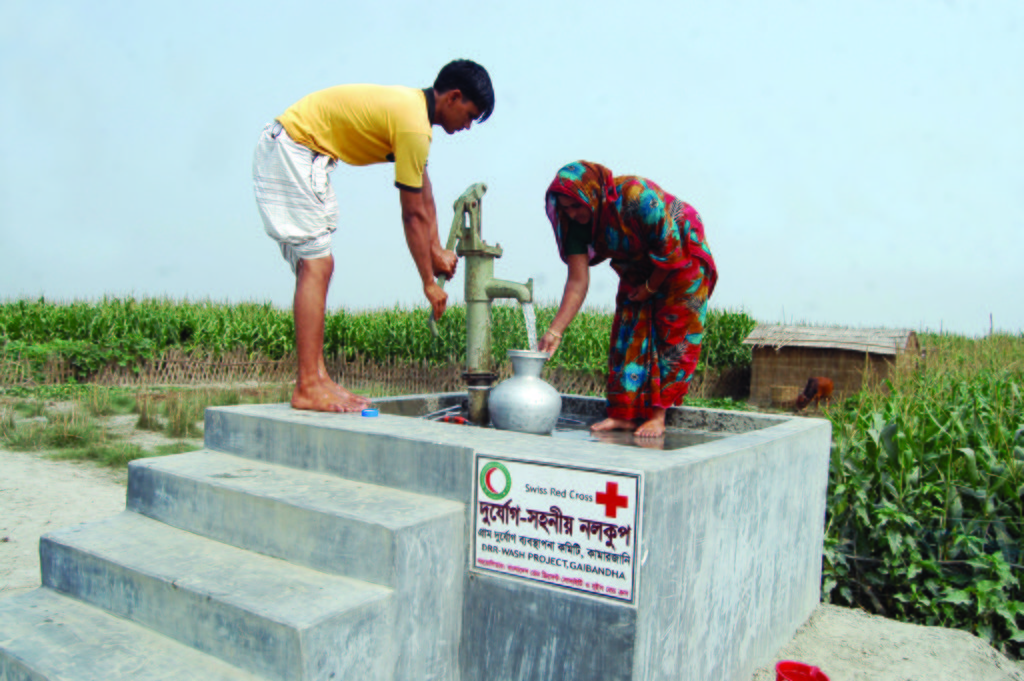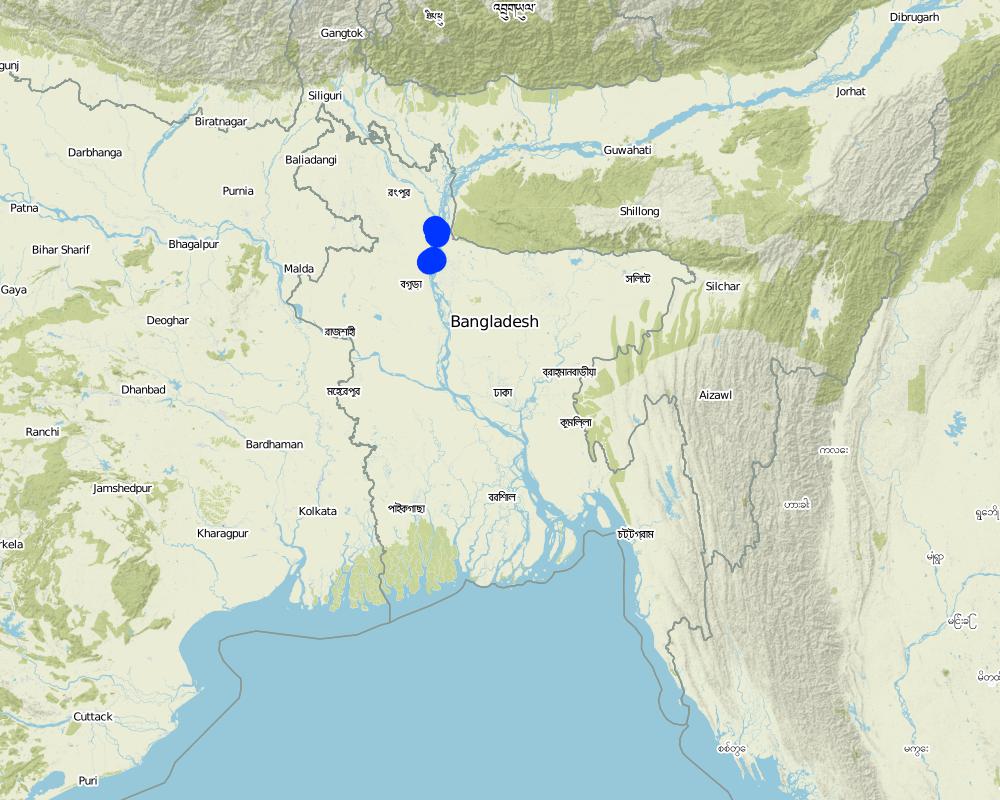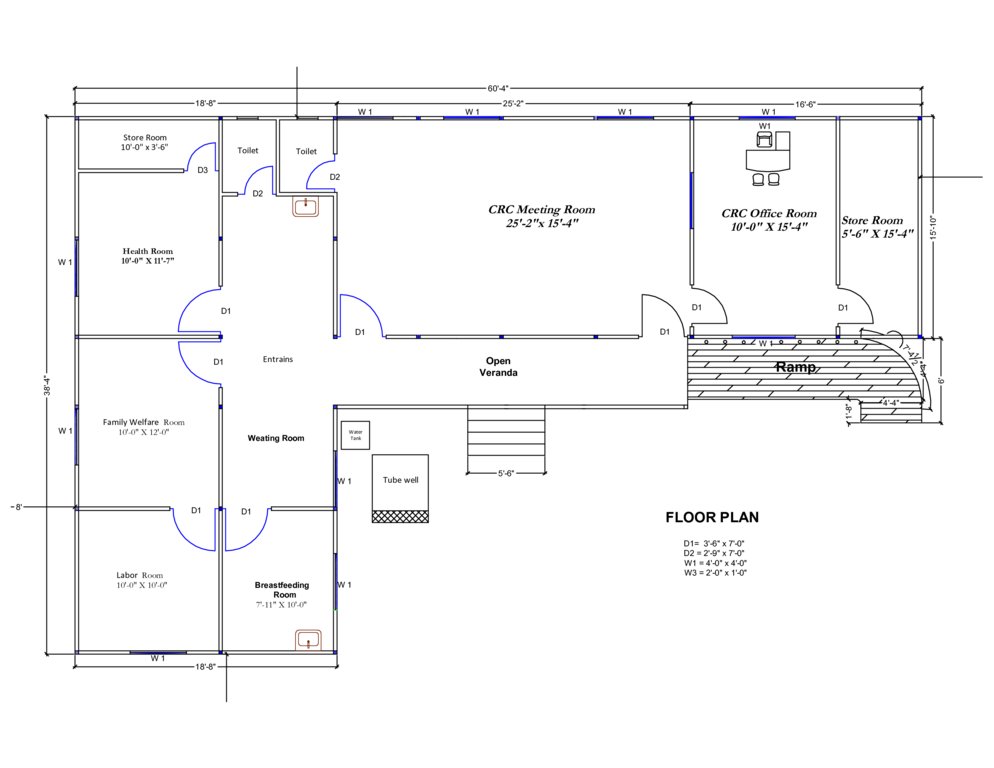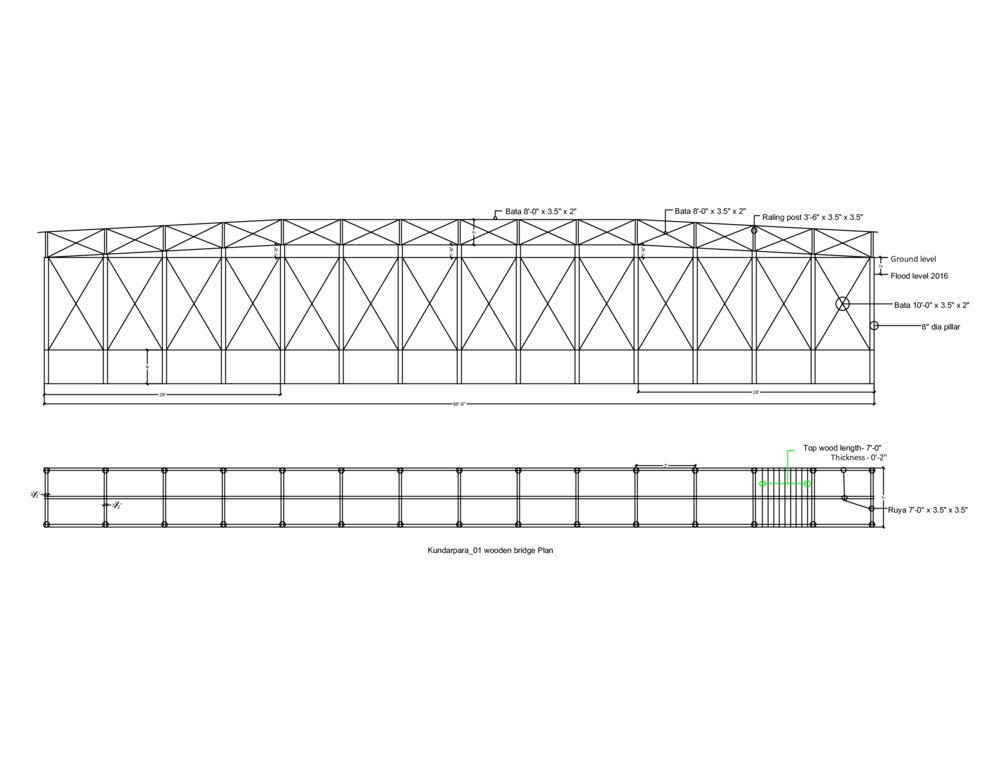Emergency infrastructure including shelter and linked transport infrastructure [孟加拉国]
- 创建:
- 更新:
- 编制者: TUHIN SAMADDAR
- 编辑者: Anton Jöhr
- 审查者: Alexandra Gavilano, Hanspeter Liniger, Nicole Harari
দুর্যোগ সহনশীন অবকাঠামো উন্নয়ন (Durjog-shahonshil abokathamo unnayon)
technologies_664 - 孟加拉国
- Emergency infrastructure, shelter and access: March 28, 2017 (inactive)
- Emergency infrastructure including shelter and linked transport infrastructure: Aug. 2, 2017 (inactive)
- Emergency infrastructure including shelter and linked transport infrastructure: Nov. 10, 2017 (inactive)
- Emergency infrastructure including shelter and linked transport infrastructure: March 5, 2019 (public)
查看章节
全部展开 全部收起1. 一般信息
1.2 参与该技术评估和文件编制的资源人员和机构的联系方式
关键资源人
Project Staff:
Mustafa Golam
Bangladesh Red Crescent Society
孟加拉国
Project Staff:
Razzak Abdur
Bangladesh Red Crescent Society
孟加拉国
Project Staff:
Islam Saiful
Bangladesh Red Crescent Society
孟加拉国
有助于对技术进行记录/评估的项目名称(如相关)
Book project: where people and their land are safer - A Compendium of Good Practices in Disaster Risk Reduction (DRR) (where people and their land are safer)有助于对技术进行记录/评估的机构名称(如相关)
Swiss Red Cross (Swiss Red Cross) - 瑞士1.3 关于使用通过WOCAT记录的数据的条件
编制者和关键资源人员接受有关使用通过WOCAT记录数据的条件。:
是
1.4 所述技术的可持续性声明
这里所描述的技术在土地退化方面是否存在问题,导致无法被认为是一种可持续的土地管理技术?:
否
注释:
The technology presented has no direct bearing on land degradation.
1.5 参考关于SLM方法(使用WOCAT记录的SLM方法)的调查问卷
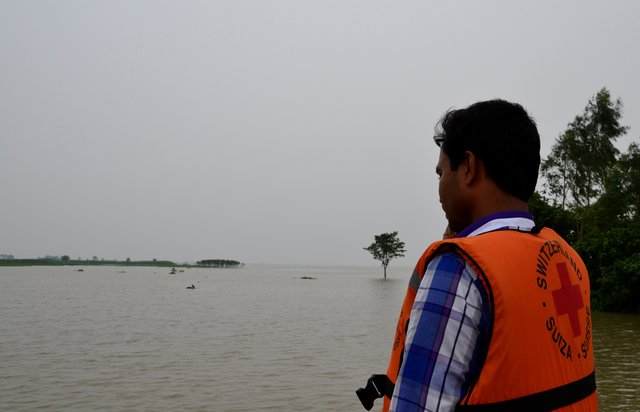
Early Warning Message Dissemination [孟加拉国]
An effective system for dissemination of early warning messages was established among the vulnerable communities in Chars (riverine sandy islands) of Gaibandha district, Bangladesh, in order to strengthen their coping mechanisms and reduce loss and damage caused by floods.
- 编制者: TUHIN SAMADDAR
2. SLM技术的说明
2.1 技术简介
技术定义:
Emergency infrastructure including shelter and linked transport infrastructure, consists in establishing specific flood shelters (for people and animals) including flood-proof collective water sources and communication infrastructure as well as health and school facilities that may serve at the same time as emergency shelters during floods.
2.2 技术的详细说明
说明:
The technology applies to the specific context of the ‘Char’ land in Bangladesh, characterised as riverine sandy Islands along the Jamuna River. More than 80% of the land in the intervention area can be classified as 'Char' and is inhabited by 60% of the population served by the project. Every year, especially during floods, the rivers deposit huge amount of silt sediment that makes the land fertile. At the same time, river action washes away some portion of the 'Char' which at times can be quite large and has a strong impact on people's lives and livelihoods. Before the intervention, people living on 'Char' land depended on their traditional early warning mechanisms and were frequently surprised by floods that destroyed their crops and put their lives in danger. Due to recurring floods, people didn’t have the means to improve their built environment. The 'Char' land is furthermore characterised by its lack of public infrastructure and remoteness to public services.
The technology consists of setting up an emergency infrastructure and ensuring community access to these infrastructures during times of floods. It has to be understood in close interrelation with the approach of setting up an early warning system. The emergency infrastructure includes specific flood shelters (for people and animals), flood-proof collective water sources and sanitation systems, transport infrastructure such as foot bridges and elevated rural roads, as well as flood-proof health and school facilities that also serve as emergency shelters during floods. The flood shelters are built on a raised bed of soil and located at sites selected by the communities that are relatively better protected from flood and river erosion within the 'Chars'. The purpose of the technology is to ensure safety of life and protection of assets during times of emergency and also to mitigate sufferings related to floods. The flood shelter is an elevated plane land which is on an average 220 square feet by size and at least five feet high from the existing ground level. The site is selected by the community and should be connected through an elevated road to the nearest community. This arrangement helps people to get easy access during times of floods. The shelter has collective hygienic latrine facilities and safe water sources. People generally dismantle their housing while evacuating and reinstall it on the flood shelter.
The major activities include facilitating the development of community-led risk reduction action plans and their implementation through community participation and engagement of local governance institutions. This includes maintenance of the built infrastructure as the joint responsibility of the community and the local government. Land use, especially sowing and harvesting, is increasingly linked to flood related forecasting measures which has led to significant adaptation in the timing of farming activities. This coupled with the creation and access to emergency infrastructure allows for a relatively safe and healthy living. The adopted technology and approach has led to adapted livelihoods, reduced health costs and increased income. The technology has furthermore led to mainstreaming disaster risk management in policies and approach of local government institutions. Increasingly the local government’s cash and food for work programmes are targeting establishment and/or reinforcement of emergency infrastructure that can cater to larger population. Increased investments are made especially towards flood shelters and improving communication and access to emergency infrastructure. Since the technology is based on local knowledge and has been developed in consultation with the involved communities, it is generally well accepted with a fair degree of ownership and involvement. However, parts of the region are also prone to river erosion and this has a destructive impact on built infrastructures. The technology does not assure any safeguard against this form of uncertain river action.
2.3 技术照片
关于照片的一般说明:
Glimpse of few technologies that served as emergency infrastructure, shelter and access to health and water and sanitation facilities.
2.5 已应用该技术的、本评估所涵盖的国家/地区/地点
国家:
孟加拉国
区域/州/省:
North-Bengal
有关地点的进一步说明:
Kamarjani and Mollar Char Union (i.e. municipality) in Sadar Upazila and Haldia Union in Shaghata Upazila of Gaibandha District
具体说明该技术的分布:
- 均匀地分布在一个区域
如果不知道精确的区域,请注明大致覆盖的区域:
- 1-10 平方千米
注释:
Since the disaster resilient infrastructure set up by the project is installed at a huge number of sites (as indicated in the description above), only a sample of the various emergency infrastructures are indicated on the map above (If needed a comprehensive GPS reading of all infrastructure built by the project can be provided separately).
Though emergency infrastructures are built at specific sites, their use and benefits are evenly spread over an expanded area.
Map
×2.6 实施日期
注明实施年份:
2014
如果不知道确切的年份,请说明大概的日期:
- 不到10年前(最近)
2.7 技术介绍
详细说明该技术是如何引入的:
- 作为传统系统的一部分(> 50 年)
- 通过项目/外部干预
注释(项目类型等):
The technology has elements of traditional practice (raised plinths for flood protection) and project promoted interventions (emergency shelter and access infrastructure).
3. SLM技术的分类
3.1 该技术的主要目的
- 降低灾害风险
- 创造有益的经济影响
- 创造有益的社会影响
3.2 应用该技术的当前土地利用类型

农田
- 一年一作
- 多年一作(非木材)
年作 - 具体指明作物:
- 谷物类 - 玉米
- 谷类 - 其他
- 谷类 - 水稻(湿地)
- 谷类 - 小麦(冬季)
- 豆科牧草和豆类 - 其他
- 根/块茎作物 - 红薯、山药、芋头/椰子,其他
- 蔬菜 - 叶菜(色拉、卷心菜、菠菜和其他)
- Kharif and Rabi (Cereals)
多年生(非木质)作物 - 指定作物:
- 药用、芳香、杀虫植物 - 多年生植物
每年的生长季节数:
- 3
具体说明:
Kharif (monsoon crop), Rabi (winter crop), and Summer/pre-monsoon crop

牧场
- Every household have at least a pair or more of livestock.
动物类型:
- 水牛
- 牛 - 非奶牛牛肉
- 牛 - 非乳制品工作
- 山羊
- 骡子和驴
- 绵羊
是否实行作物与牲畜的综合管理?:
否

定居点、基础设施
- 定居点、建筑物
- 交通:公路、铁路
注释:
Despite the lack of public infrastructure and services and being exposed to natural hazards people tend to prefer to live in the 'Char' as it brings significant economic benefits for them: crops grow rapidly and abundantly with significantly lower input costs than on the mainland.
Cow, buffalo, goat, lamb and donkey are very common in the area. People rear these for cultivation, transportation and for having meat. Every household have at least a pair or more of livestock.
3.4 供水
该技术所应用土地的供水:
- 混合雨水灌溉
注释:
Water supply for the land comprises a mix of rainfed, irrigated and post flooding sources.
3.5 该技术所属的SLM组
- Emergency infrastructure, shelter and linked transportation infrastructure
3.6 包含该技术的可持续土地管理措施

结构措施
- S9:动植物庇护所
- S11:其它

管理措施
- M4:活动时间安排的重大变化
注释:
In addition to the structural and management measures described above, the technology involves additional elements such as flood-proof collective water supply and sanitation systems and communication infrastructure.
3.7 该技术强调的主要土地退化类型

土壤水蚀
- Wr:河岸侵蚀
- Wo:场外劣化效应
注释:
N/A
3.8 防止、减少或恢复土地退化
具体数量名该技术与土地退化有关的目标:
- 适应土地退化
注释:
NA
4. 技术规范、实施活动、投入和成本
4.1 该技术的技术图纸
技术规范(与技术图纸相关):
The built structural mitigation options have following technical specification:
1. Flood shelter: Dimension: Length-220' x Width-220' x Height- 5.5', Slope: 1:1.5, Capacity: 350 families, Construction material used: soil and turfing (grass)
2. Raised school compound: Dimension: Length-112' x Width-75' x Height- 5.5', Slope: 1:1.5, Capacity: 540 person, Construction material used: soil and turfing (grass)
3. Community Resource Centre and Community Clinic (CRC-CC): Dimension: Length-60' x Width-38' x Height- 5.6', Slope: 1:1.5, Capacity: 1500 families from 5 villages, Construction material used: soil and grass plantation, bricks, sand, cement, rod, iron angel and CGI sheet.
4. Disaster resilient tube well: Dimension: Length-5' 10" x Width-5' x Height- 3', Boring: 100 feet, Capacity: 200 families, Construction material used: bricks, sand, cement, rod, tube well head, pvc pipe, cylinder, piston rod etc. Vertical intervals: 2 in each village.
5. Concrete platform for (existing) tube well: Dimension: Length-4' 10" x Width-4' x Height- 1', Capacity: 100 families, Construction material used: bricks, sand, cement, pvc pipe
6. Wooden bridge: Dimension: Length-99' x Width-7' x Height- 12', Slope: 1:1.5, Capacity: 900 families approximately, Construction material used: wood, nails, tar, soil and grass plantation
7. Road construction/repair: Dimension: Length-925' x Width-12' x Height- 3' (from existing level), Slope: 1:1.5, Capacity: 3 villages (approx:1000 families), Construction material used: soil and turfing (grass).
作者:
Abdur Razzak
日期:
17/10/2016
4.2 有关投入和成本计算的一般信息
具体说明成本和投入是如何计算的:
- 每个技术单元
指定单位:
flood shelter, raised school compound, disaster resilient tube well, concrete platform for (existing) tube well, wooden bridge, road construction/repair
指定单位面积(如相关):
road: per meter
其它/国家货币(具体说明):
Bangladeshi Taka (BDT)
如相关,注明美元与当地货币的汇率(例如1美元=79.9巴西雷亚尔):1美元=:
79.0
注明雇用劳工的每日平均工资成本:
350 BDT
4.3 技术建立活动
| 活动 | 时间(季度) | |
|---|---|---|
| 1. | Construction of Flood Shelter | During dry season |
| 2. | Raising school compound | During dry season |
| 3. | Construction of Community Resource Center (CRC) | During dry season |
| 4. | Installation of disaster resilient tube well | During dry season |
| 5. | Construction of concrete platform for (existing) tube well | During dry season |
| 6. | Construction of wooden bridge | During dry season |
| 7. | Road construction above flood level | During dry season |
注释:
All activities are structural in nature and can be undertaken efficiently only in dry season.
4.4 技术建立所需要的费用和投入
| 对投入进行具体说明 | 单位 | 数量 | 单位成本 | 每项投入的总成本 | 土地使用者承担的成本% | |
|---|---|---|---|---|---|---|
| 劳动力 | Flood shelter: earth work | m3 | 8000.0 | 64.0 | 512000.0 | 10.0 |
| 劳动力 | CRC: earth work | m3 | 53.0 | 138.0 | 7314.0 | 10.0 |
| 劳动力 | CRC: sand filling | m3 | 302.0 | 99.0 | 29898.0 | 10.0 |
| 劳动力 | Raised school compound: earth work | m3 | 1790.0 | 64.0 | 114560.0 | 10.0 |
| 植物材料 | Flood shelter: grass plantation (turfing) | m2 | 4620.0 | 13.0 | 60060.0 | 10.0 |
| 植物材料 | Flood shelter: seedlings | piece | 20.0 | 53.0 | 1060.0 | 10.0 |
| 植物材料 | CRC: grass plantation (turfing) | m2 | 3890.0 | 13.0 | 50570.0 | 10.0 |
| 植物材料 | CRC: seedlings | piece | 50.0 | 53.0 | 2650.0 | 10.0 |
| 植物材料 | Raised school compound: grass plantation (turfing) | m2 | 1390.0 | 13.0 | 18070.0 | 10.0 |
| 植物材料 | Raised school compound: seedlings | piece | 40.0 | 53.0 | 2120.0 | 10.0 |
| 施工材料 | CRC: roof truss | kg | 4375.0 | 100.0 | 437500.0 | |
| 施工材料 | CRC: grill and iron work | m2 | 88.0 | 2091.0 | 184008.0 | |
| 施工材料 | CRC: gypsum board | m2 | 478.0 | 922.0 | 440716.0 | |
| 施工材料 | CRC: RCC work | m3 | 2.9 | 19557.0 | 56715.3 | |
| 施工材料 | CRC: deformed bar | kg | 397.0 | 85.0 | 33745.0 | |
| 施工材料 | CRC: boundary fencing | m2 | 184.0 | 440.0 | 80960.0 | |
| 施工材料 | CRC: brick work | m3 | 44.0 | 5515.0 | 242660.0 | |
| 其它 | CRC: electric ware and solar panel | lumpsum | 1.0 | 73000.0 | 73000.0 | |
| 其它 | CRC: water supply | lumpusm | 1.0 | 66150.0 | 66150.0 | |
| 其它 | CRC: transportation | lumpsum | 1.0 | 89000.0 | 89000.0 | |
| 技术建立所需总成本 | 2502756.3 | |||||
| 技术建立总成本,美元 | 31680.46 | |||||
如果土地使用者负担的费用少于100%,请注明由谁负担其余费用:
10% of all construction cost (except community resource center) is borne by the user. Another 15% is provided by the local government bodies. The remaining 75% is subsidised by the project.
注释:
Defining costs of establishment is bit tricky as the measures differ in size and number, costs vary from one village to another depending on the geographical location. However, average costs of the measures further to those highligted in the table are given below:
Disaster resilient tube well: labour (mason) 3'000, equipment (drilling charge) 1800, construction material (bricks, cement, sand, iron rod, PVC pipe, cylinder, GI pipe, tubewell head) 23'250, transportation 2'650, total unit costs (BDT) 30'700
Concrete platform for (existing) tube well : labour (mason) 600, construction material (bricks, cement, sand) 2'450, other (Transportation, waste water disposal) 1650, total unit costs (BDT) 4'700
Wooden bridge: labour (mason, mason assitant, painting assistant, earthwork) 30'000, plant material (grass plantation) 12'500, equipment (painting brush etc.) 1'000, construction material (timber, nails, tar, tarpin oil, paint) 260'000, Transportation 30'000, total unit costs (BDT) 333'500
Road construction/repair: labour (earthwork) 102'500, plant material (grass plantation/turfing), 12'500, total unit costs (BDT) 115'000
4.5 维护/经常性活动
| 活动 | 时间/频率 | |
|---|---|---|
| 1. | Construction of Flood Shelter | During dry season |
| 2. | Raising school compound | During dry season |
| 3. | Construction of Community Resource Center (CRC) | During dry season |
| 4. | Installation of disaster resilient tube well | During dry season |
| 5. | Construction of concrete platform ror (existing) tube well | During dry season |
| 6. | Construction of wooden bridge | During dry season |
| 7. | Road construction above flood level | During dry season |
注释:
Due to the softness of the sandy soil and the annual inundation, every measure requires considerable maintenance. The flooding generally washes out sands and decays the foundation of the structure. If maintenance is done in regular intervals, the entire structure remains functional. Also, grass needs to be frequently replanted as it dries up during the dry season.
The users and the local government (Union Disaster Management Committee) are mainly responsible for maintenance of all built assets and structures including the Community Resource Center. The relevant operation/repair and maintenance training has been provided by the project.. Maintenance manuals and guidelines have been developed and disseminated. Also, repair and maintenance equipment has been provided to cadre of users/caretakers trained in repair/maintenance work.
4.6 维护/经常性活动所需要的费用和投入(每年)
| 对投入进行具体说明 | 单位 | 数量 | 单位成本 | 每项投入的总成本 | 土地使用者承担的成本% | |
|---|---|---|---|---|---|---|
| 劳动力 | Earthwork | m3 | 80.0 | 63.0 | 5040.0 | 10.0 |
| 劳动力 | Sand bag filling | piece | 50.0 | 15.0 | 750.0 | 10.0 |
| 劳动力 | Pipe fitting | piece | 2.0 | 300.0 | 600.0 | 10.0 |
| 劳动力 | Mason | lumpsum | 1.0 | 500.0 | 500.0 | 10.0 |
| 植物材料 | Grass plantation (turfing) | m2 | 85.0 | 13.0 | 1105.0 | 10.0 |
| 植物材料 | Seedlings | piece | 15.0 | 53.0 | 795.0 | 10.0 |
| 施工材料 | Plastic bag | piece | 50.0 | 10.0 | 500.0 | 10.0 |
| 施工材料 | PVC pipe | m | 15.0 | 120.0 | 1800.0 | 10.0 |
| 施工材料 | Polythene pipe | kg | 5.0 | 160.0 | 800.0 | 10.0 |
| 施工材料 | Ciment | bag | 0.5 | 540.0 | 270.0 | 10.0 |
| 施工材料 | Sand | ft3 | 5.0 | 18.0 | 90.0 | 10.0 |
| 施工材料 | Caping socket | piece | 2.0 | 35.0 | 70.0 | 10.0 |
| 施工材料 | Tape etc. | lumpsum | 1.0 | 250.0 | 250.0 | 10.0 |
| 技术维护所需总成本 | 12570.0 | |||||
| 技术维护总成本,美元 | 159.11 | |||||
如果土地使用者负担的费用少于100%,请注明由谁负担其余费用:
Maintenance costs are to date (2017) distributed as construction (10% by the users, 15% by the local government). A cost transfer scheme to the users and local government for maintenance is developped to be applied in the follow-up phase.
注释:
Again, defining costs of maintenance is also not easy as the measures differ in size and number. Average costs of the measures, further to those for flood shelter including disaster resilient tube well as highligted in the table, are given below:
Raised school compound: labour (earth work and sand bag filling) 7'800, plant material (grass plantation) 1'000, construction material (plastic bag, rope) 500, total unit maintenance costs (BDT) 9'300
Community resource Center (CRC): labour 1'200, plant material (grass plantation, seedlings) 10'500, Transportation 1'000, total unit maintenance costs (BDT) 12'700
Concrete platform for (existing) tube well : labour (mason) 500, construction material (bricks, cement, sand) 600, total unit maintenance costs (BDT) 1'100
Wooden bridge: labour (earthwork) 2'500, plant material (grass plantation) 3'000, construction material (plastic bag, rope) 2'000, total unit maintenance costs (BDT) 7'500
Road construction/repair: labour (earthwork) 10'000, plant material (grass plantation/turfing), 1'500, construction material (plastic bag, rope) 500, total unit maintenance costs (BDT) 12'000
4.7 影响成本的最重要因素
描述影响成本的最决定性因素:
Transportation of raw material from the mainland to the sites on the 'Char' Islands varies across seasons. In the dry season it is much higher compared to monsoon as the delivery of material is easier in the latter due to extended river outreach.
5. 自然和人文环境
5.1 气候
年降雨量
- < 250毫米
- 251-500毫米
- 501-750毫米
- 751-1,000毫米
- 1,001-1,500毫米
- 1,501-2,000毫米
- 2,001-3,000毫米
- 3,001-4,000毫米
- > 4,000毫米
指定年平均降雨量(若已知),单位为mm:
2134.80
有关降雨的规范/注释:
Rainy season: April- October
Occurrence of heavy rain: June-July
Length of dry period: November-March
注明所考虑的参考气象站名称:
18 Gaibandha Sadar, Gaibandha
农业气候带
- 潮湿的
Tropical humid climatic zone.
Temperature: maximum 33.5°C, minimum 10.5°C
5.2 地形
平均坡度:
- 水平(0-2%)
- 缓降(3-5%)
- 平缓(6-10%)
- 滚坡(11-15%)
- 崎岖(16-30%)
- 陡峭(31-60%)
- 非常陡峭(>60%)
地形:
- 高原/平原
- 山脊
- 山坡
- 山地斜坡
- 麓坡
- 谷底
垂直分布带:
- 0-100 m a.s.l.
- 101-500 m a.s.l.
- 501-1,000 m a.s.l.
- 1,001-1,500 m a.s.l.
- 1,501-2,000 m a.s.l.
- 2,001-2,500 m a.s.l.
- 2,501-3,000 m a.s.l.
- 3,001-4,000 m a.s.l.
- > 4,000 m a.s.l.
说明该技术是否专门应用于:
- 不相关
关于地形的注释和进一步规范:
Information on altitudinal zone collected from the website: www.getamap.net
5.3 土壤
平均土层深度:
- 非常浅(0-20厘米)
- 浅(21-50厘米)
- 中等深度(51-80厘米)
- 深(81-120厘米)
- 非常深(> 120厘米)
土壤质地(表土):
- 中粒(壤土、粉土)
- 细粒/重质(粘土)
土壤质地(地表以下> 20厘米):
- 粗粒/轻(砂质)
- 中粒(壤土、粉土)
表土有机质:
- 中(1-3%)
如有可能,附上完整的土壤描述或具体说明可用的信息,例如土壤类型、土壤酸碱度、阳离子交换能力、氮、盐度等。:
N/A
5.4 水资源可用性和质量
地下水位表:
5-50米
地表水的可用性:
中等
水质(未处理):
良好饮用水
水的盐度有问题吗?:
否
该区域正在发生洪水吗?:
是
规律性:
频繁
关于水质和水量的注释和进一步规范:
In the dry season water crisis occurs. Open defecation and use of pesticide in farming are key pollutants of water sources.
5.5 生物多样性
物种多样性:
- 中等
栖息地多样性:
- 中等
关于生物多样性的注释和进一步规范:
Biodiversity can be rated as moderate or medium both in terms of species and habitat. It is stable and and often self generating.
5.6 应用该技术的土地使用者的特征
定栖或游牧:
- 定栖的
- 半游牧的
生产系统的市场定位:
- 混合(生计/商业)
非农收入:
- 低于全部收入的10%
相对财富水平:
- 贫瘠
个人或集体:
- 个人/家庭
- 团体/社区
机械化水平:
- 畜力牵引
- 机械化/电动
性别:
- 女人
- 男人
土地使用者的年龄:
- 青年人
- 中年人
说明土地使用者的其他有关特征:
N/A
5.7 应用该技术的土地使用者使用的平均土地面积
- < 0.5 公顷
- 0.5-1 公顷
- 1-2 公顷
- 2-5公顷
- 5-15公顷
- 15-50公顷
- 50-100公顷
- 100-500公顷
- 500-1,000公顷
- 1,000-10,000公顷
- > 10,000公顷
这被认为是小规模、中规模还是大规模的(参照当地实际情况)?:
- 小规模的
注释:
People living in Chars have small landholding which often produces enough for subsistence and, in some cases, for market purposes.
5.8 土地所有权、土地使用权和水使用权
土地所有权:
- 州
- 个人,未命名
土地使用权:
- 自由进入(无组织)
- 租赁
用水权:
- 社区(有组织)
- 个人
注释:
Land ownership is quite complex as Chars by nature are unstable habitats. In principle land is owned by state but in most cases the politician - musclemen nexus exercises real control. This results in leasing and renting of land which is the predominant form of land ownership in Chars.
5.9 进入服务和基础设施的通道
健康:
- 贫瘠
- 适度的
- 好
教育:
- 贫瘠
- 适度的
- 好
技术援助:
- 贫瘠
- 适度的
- 好
就业(例如非农):
- 贫瘠
- 适度的
- 好
市场:
- 贫瘠
- 适度的
- 好
能源:
- 贫瘠
- 适度的
- 好
道路和交通:
- 贫瘠
- 适度的
- 好
饮用水和卫生设施:
- 贫瘠
- 适度的
- 好
金融服务:
- 贫瘠
- 适度的
- 好
Access to mobile phone and internet:
- 贫瘠
- 适度的
- 好
6. 影响和结论性说明
6.1 该技术的现场影响
社会经济效应
生产
作物生产
SLM之前的数量:
3600 kg/hectare (maize)
SLM之后的数量:
11400 kg/hectare (maize)
注释/具体说明:
Crop production has increased thrice due to stability of household which has led to stable use of land in the chars.
水资源可用性和质量
饮用水的可用性
SLM之前的数量:
No safe drinking water source was available
SLM之后的数量:
More than 40% water source are safe
注释/具体说明:
Collective water supply systems have groundwater sources and thus no treatment is needed. Further, aspects of availability, easy access and sustainable availability of sufficient water of acceptable quality are well considered. Families can access 10 litres per capita per day (LPCD) during emergencies (which is in line with Sphere standards) and during normal times 40 LPCD is what families can collect from these water sources. All such water sources are within a distance of 50 metres from the settlement as per Bangladesh standards.
饮用水的质量
SLM之前的数量:
Reliable data not available
SLM之后的数量:
All households have access to safe drinking water as per govt. standard for rural areas
注释/具体说明:
The collective water infrastructure built by the project ensures fulfillment of minimum standards set by the govt for safe drinking water.
收入和成本
农业收入
SLM之前的数量:
25% families had farm income
SLM之后的数量:
95% families have farm income
注释/具体说明:
Cattle and poultries are safe during disaster
社会文化影响
健康状况
注释/具体说明:
The disaster mitigation measures has significantly improved the health situation of the target population.
社区机构
SLM之前的数量:
Few credit groups in intervention villages
SLM之后的数量:
30 community based organisatons (i.e. village disaster management committees) and 3 Local Government Committees (Union disaster management committee)
注释/具体说明:
Community based organisations and government mandated institutions have been promoted through project initiatives.
国家机构
注释/具体说明:
CRC is also being used for UDMC office which is an important committee of union parishad.
冲突缓解
SLM之前的数量:
Widespread
SLM之后的数量:
Rare
注释/具体说明:
Conflict sensitive approach has significantly reduced the incidence of conflicts.
生态影响
水循环/径流
水量
SLM之前的数量:
Data not available
SLM之后的数量:
Same
注释/具体说明:
The disaster resilient tube well ensures year round drinking water.
减少气候和灾害风险
洪水影响
SLM之前的数量:
95% families were effected from flood
SLM之后的数量:
47% families are affected from flood
注释/具体说明:
The above figures are from 2016 when Bangladesh experienced one of the worst floods in recent times.
6.2 该技术的场外影响已经显现
对场外影响(测量)的评估进行具体说明:
N/A
6.3 技术对渐变气候以及与气候相关的极端情况/灾害的暴露和敏感性(土地使用者认为的极端情况/灾害)
气候有关的极端情况(灾害)
气象灾害
| 该技术是如何应对的? | |
|---|---|
| 局地暴雨 | 适度 |
| 当地沙尘暴/尘暴 | 好 |
| 局地风暴 | 好 |
气候灾害
| 该技术是如何应对的? | |
|---|---|
| 热浪 | 好 |
| 寒潮 | 好 |
| 干旱 | 好 |
水文灾害
| 该技术是如何应对的? | |
|---|---|
| 比较和缓的(河道)洪水 | 好 |
| 滑坡 | 不好 |
注释:
In some cases the appropriate answer would have been "not applicable" but since this is not there, we have selected "well".
6.4 成本效益分析
技术收益与技术建立成本相比如何(从土地使用者的角度看)?
短期回报:
非常积极
长期回报:
积极
技术收益与技术维护成本/经常性成本相比如何(从土地使用者的角度看)?
短期回报:
积极
长期回报:
稍微积极
注释:
The limited returns that have been generated by the project is highly valued by the users from a cost - benefit perspective; especially when they understand that the project is not directly linked to land management practices. Thus, the indirect benefits are perceived to have high value.
6.5 技术采用
- > 50%
如若可行,进行量化(住户数量和/或覆盖面积):
Out of a total of 8828 HHs targeted by the project, around five thousand HHs in three union have benefitted from the implementation of the technology.
在所有采用这项技术的人当中,有多少人是自发的,即未获得任何物质奖励/付款?:
- 0-10%
6.6 适应
最近是否对该技术进行了修改以适应不断变化的条件?:
是
若是,说明它适应了哪些变化的条件:
- 劳动力可用性(例如,由于迁移)
具体说明技术的适应性(设计、材料/品种等):
Dredging machine has been used for building some emergency infrastructure at few sites due to unavailability of labour at the time of construction.
6.7 该技术的优点/长处/机会
| 土地使用者眼中的长处/优势/机会 |
|---|
| Emergency structures are collectively owned and have a multipurpose use; in 'normal' (non-emergency) times they are used for other purpose than safety and protection which includes community meeting, workshop and training |
| Expanded opportunities of communication during flood |
| 编制者或其他关键资源人员认为的长处/优势/机会 |
|---|
| Community is aware and driven to implement flood preparedness and risk reduction measures on its own |
| Appropriate measures can significantly change people's mindset and behaviour |
6.8 技术的弱点/缺点/风险及其克服方法
| 土地使用者认为的弱点/缺点/风险 | 如何克服它们? |
|---|---|
| River erosion threatens built structures | Careful site selection for construction work through in depth discussion with community people supported by scientific analysis |
| High investment needed for building physical structures (e.g. CRC building) in the char which the local government and community find difficult to finance without external support. | Install portable semi-permanent structures in the char; Lobby for greater decentralisation of finances to local government |
7. 参考和链接
7.1 信息的方法/来源
- 与土地使用者的访谈
3
- 与SLM专业人员/专家的访谈
4
- 根据报告和其他现有文档进行编译
2
(现场)数据是什么时候汇编的?:
04/10/2016
7.2 参考可用出版物
标题、作者、年份、ISBN:
Latrine and Tube well maintenance manual, SRC-BDRCS-DASCOH
可以从哪里获得?成本如何?
SRC
链接和模块
全部展开 全部收起链接

Early Warning Message Dissemination [孟加拉国]
An effective system for dissemination of early warning messages was established among the vulnerable communities in Chars (riverine sandy islands) of Gaibandha district, Bangladesh, in order to strengthen their coping mechanisms and reduce loss and damage caused by floods.
- 编制者: TUHIN SAMADDAR
模块
无模块



